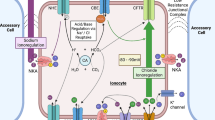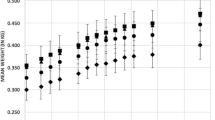Summary
-
1.
The water content ofOctopus vulgaris blood was found to be about 870 g/kg of wet tissue, while that of solid tissue was between 720–800 g/kg of wet tissue, except for the hepatopancreas that was 680 g/kg.
-
2.
Blood plasma was hyperosmotic to the seawater environment. Urine was isosmotic.
-
3.
The total cation (or anion) charge of blood plasma was 624 mEq/l, of urine 670, and of the seawater environment 646 mEq/l.
-
4.
The ionic concentration of the body fluids was higher than that found in other cephalopods; although in all cephalopods it is within 2% (98%–102%) of the ionic concentration of seawater.
-
5.
Proteins represent the major buffer system inO. vulgaris blood plasma.
-
6.
The concentration of protein and copper in the blood plasma was 10,540 and 25.5 mg% ml respectively, practically all of the copper being bound to proteins and only 0.013 mg/ml being in free form.
-
7.
The ionic concentration in the solid tissues differed slightly according to the tissue examined. High levels of sodium chloride were found in the branchial heart and in the branchial gland. Potassium was higher in the brain and white body, while iron and copper levels were highest in the hepatopancreas.
-
8.
Ammonia and amino acids were the major free compounds inO. vulgaris urine and solid tissue, respectively. The ammonia and urea levels were higher in solid tissues than in blood, and in some tissues (brain and hepatopancreas) they were more than 20 times as high. Uric acid occurred in kidney and hepatopancreas in concentrations above 50 mg/100 g of tissue water, but it was absent from other tissues (except brain).
Similar content being viewed by others
References
Bohuon C (1962) Microdosage du magnesium dans divers milieux biologiques. Clin Chim Acta 7:811–817
Campbell JW, Bishop S (1970) Nitrogen metabolism in molluscs. In: Campbell TW (ed) Comparative biochemistry of nitrogen metabolism, vol I. Academic Press, London New York, pp 182–185
Deffner GGT, Mafter RF (1960) Chemical investigations of the giant nerve fibers of the squid. IV. Acid-base balance in axoplasm. Biochim Biophys Acta 42:200–205
Deffner GGT (1961) The dialyzable free organic constituents of squid blood: a comparison with nerve axoplasm. Biochim Biophys Acta 47:378–388
Delaunay M (1931) L'excrétion azotée des invertebrates. Biol Rev 6:265–302
Doi E, Shibata D, Matoba T (1981) Modified colorimetric ninhydrin methods for peptidase assay. Anal Biochem 118:173–184
Emanuel CF, Martin AW (1956) The composition of octopus renal fluid. Z Vergl Physiol 39:226–234
Felsenfeld G (1960) The determination of cuprous ion in copper proteins. Arch Biochem Biophys 87:247–251
Fiske CM, Subbarow Y (1925) The colorimetric determination of phosphorus. J Biol Chem 66:375–400
Forrester RL, Wataji LJ, Silverman DA, Pierre KJ (1976) Enzymatic method for determination of CO2 in serum. Clin Chem 22:243–245
George RC (1981) An enzymatic bicarbonate reagent that is free of pyruvate interference. Clin Chem 27:199
Ghiretti F (1956) The decomposition of hydrogen peroxide by hemocyanin and by its dissociation products. Arch Biochem Biophys 63:177–191
Ghiretti F (1962) In: Hayaishi O (ed) Oxygenases. Academic Press, New York, pp 517–553
Gornall AG, Bardawill CS, David MM (1949) Determination of serum proteins by means of the biuret reaction. J Biol Chem 177:751–766
Grant GH, Path BM, Kachmar JF (1976) The proteins of body fluids. In: Tietz WT (ed) Fundamentals of clinical chemistry. Saunders, Philadelphia London Toronto, pp 308–314
Gutmann I, Bergmeyer HU (1974) Urea. In: Bergmeyer HU (ed) Methods of enzymatic analysis, vol IV, 2nd edn (Transl from 3rd German ed). Verlag Chemie, Weinheim; Academic Press, New York London, pp 1791–1798
Hare RS (1950) Endogenous creatinine in serum and urine. Proc Soc Exp Biol Med 74:148–151
Itano MMD, Williams ABS, Zac BPhD (1959) Spectrophotometric determination of chloride in urine. Am J Clin Pathol 32:213–215
Kageyama N (1971) A direct colorimetric determination of uric acid in serum and urine with uricase-catalase system. Clin Chim Acta 31:421–426
Kun E, Kearney EB (1974) Ammonia. In: Bergmeyer HU (ed) Methods of enzymatic analysis. vol IV, 2nd edn (Transl from 3rd German ed). Verlag Chemie, Weinheim; Academic Press, New York London pp 1802–1806
Magaldi AG, Nardi G (1963) Preparation of copper-free hemocyanin and its reconstitution inOctopus vulgaris. In: Peeters H (ed) Protides of the biological fluids, vol II. pp 507–509
Magaldi AG, Nuzzolo C, Ghiretti F (1966) Chemical studies on hemocyanins. I. Amino acid composition. Biochemistry 5:1943–1951
Mamose T, Ohkura Y, Tomita J (1965) Determination of urea in blood and urine with diacetyl monoxime-glucuronolactone reagent. Clin Chem 11:113–121
Morrison GR (1971) Microchemical determination of organic nitrogen with Nessler reagent. Anal Biochem 43:525–532
Nardi G, Zito R (1968) Spectrophotometric titration of hemocyanin fromOctopus vulgaris. Pubbl Staz Zool Napoli 36:501–509
Nardi G, Puca M, Jamunno G (1970) Ricostruzione in vitro dell'emocianina da composti a rame dell'epatopancreas diOctopus vulgaris Lamarck. Pubbl Staz Zool Napoli 38:102–108
Potts WTW (1965) Ammonia excretion inOctopus dofleini. Comp Biochem Physiol 14:339–355
Potts WTW (1967) Excretion in the molluscs. Biol Rev 42:1–41
Potts WTW, Todd M (1965) Kidney function in the Octopus. Comp Biochem Physiol 16:479–489
Robertson JD (1949) Ionic regulation in some marine invertebrates. J Exp Biol 26:181–200
Robertson JD (1953) Further studies on ionic regulation in marine invertebrates. J Exp Biol 30:277–296
Robertson JD (1960) Studies on the chemical composition of muscle tissue. I. The muscle of the hagfish,Myxine glutinosa L. and the roman cel,Musaena hilena L. J Exp Biol 37:879–888
Robertson JD (1965) Studies on the chemical composition of muscle tissue. III. The mantle muscle of Cephalopod molluscs. J Exp Biol 42:153–175
Rocca E (1969) Copper distribution inOctopus vulgaris Lam. hepatopancreas. Comp Biochem Physiol 28:67–82
Sarkar BCR, Chauhan UPS (1967) A new method for determining microquantities of calcium in biological materials. Anal Biochem 20:155–166
Wahlefeld AW, Holz G (1974) In: Bergmeyer HU (ed) Methods of enzymatic analysis, vol IV, 2nd edn (Transl from 3rd German ed). Verlag Chemie, Weinheim, Academic Press, New York London, pp 1786–1790
Zac B (1958) Simple procedure for the single sample determination of serum copper and iron. Clin Chim Acta 3:328–334
Author information
Authors and Affiliations
Rights and permissions
About this article
Cite this article
D'Aniello, A., Strazzullo, L., D'Onofrio, G. et al. Electrolytes and nitrogen compounds of body fluids and tissues ofOctopus vulgaris Lam.. J Comp Physiol B 156, 503–509 (1986). https://doi.org/10.1007/BF00691036
Accepted:
Issue Date:
DOI: https://doi.org/10.1007/BF00691036




